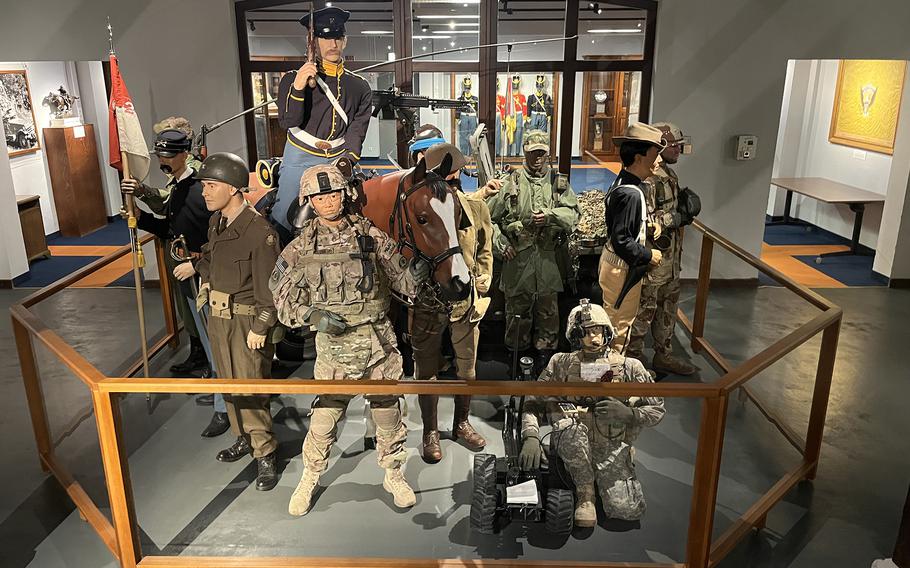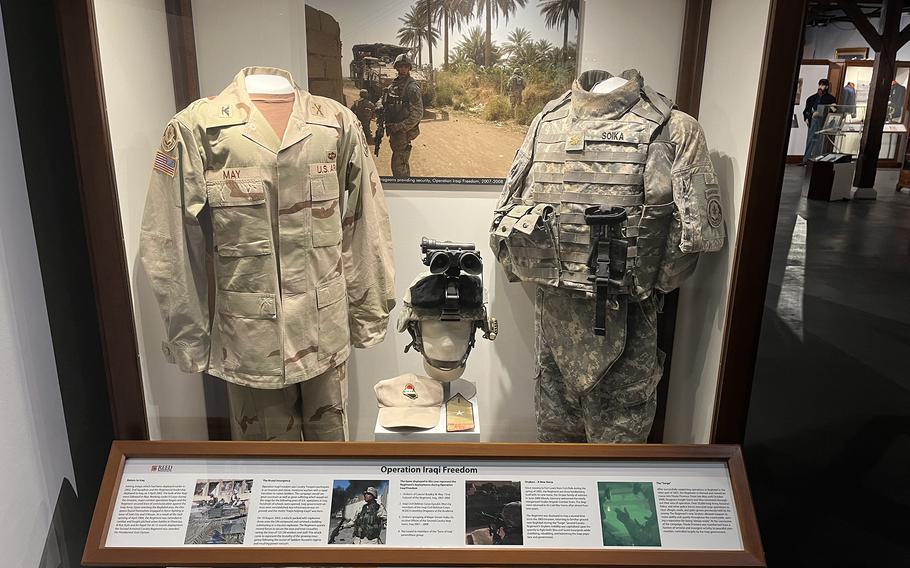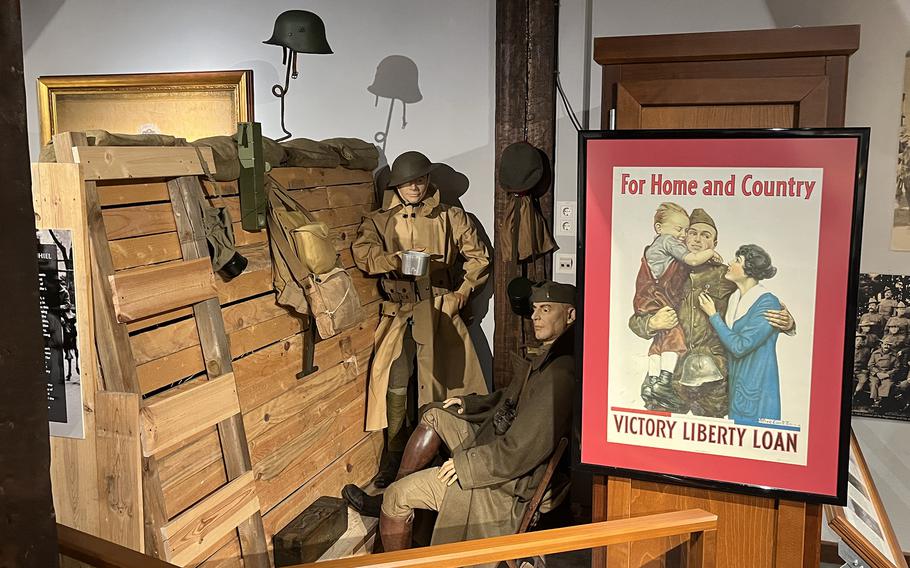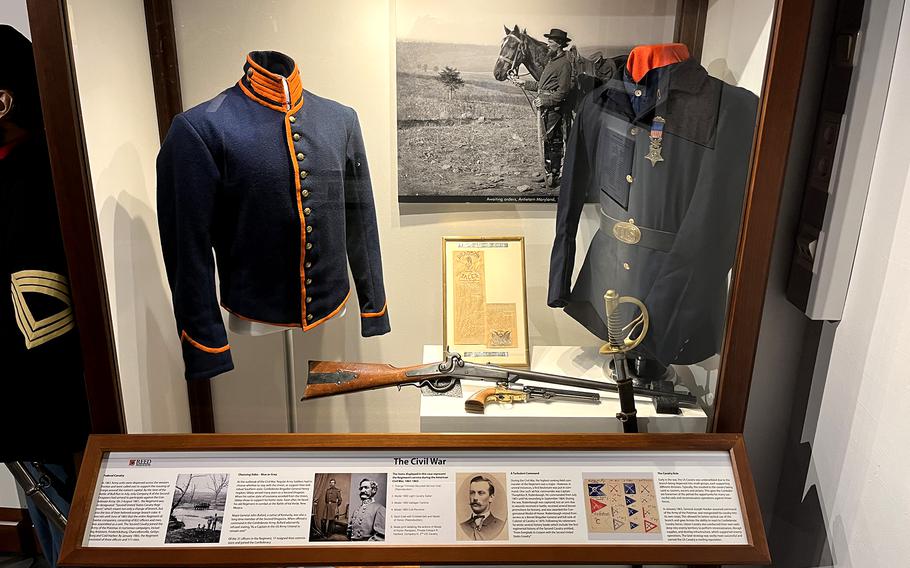
The 2nd Cavalry Regiment Museum in Vilseck, Germany, is shown June 6, 2025. The regiment's storied history from its formation in 1836 to present day is told through exhibits at the museum, which is among 29 on a closure list compiled by the U.S. Army Center of Military History. (Matthew M. Burke/Stars and Stripes)
RAMSTEIN, Germany — Dozens of Army museums around the world dedicated to units, some among the most storied in the service, will disappear over the next three years as part of cost-cutting and efforts to align with Pentagon priorities.
The U.S. Army Center of Military History announced plans Wednesday to close or consolidate 29 of its 41 active-duty museums to direct more resources toward “readiness and lethality,” a statement on the center’s Facebook page said.
The official list of closures has not been released pending approval from Army headquarters, but center spokesman F. Lee Reynolds confirmed Thursday that it had leaked online.

A display commemorating Operation Iraqi Freedom is seen June 6, 2025, at the 2nd Cavalry Regiment Museum in Vilseck, Germany, which features exhibits from the regiment's formation in 1836 to present. A proposal to shutter 29 Army museums over the next three years includes the one in Vilseck. (Matthew M. Burke/Stars and Stripes)
Among the facilities proposed for shutdown are the 82nd Airborne Division War Memorial Museum at Fort Bragg, N.C., and the 2nd Cavalry Regiment Museum in Vilseck, Germany.
“The problem is we’re not getting additional money, so we have not been able to staff the museums the way we would like to and conduct the maintenance and rotate exhibits the way we would like,” Reynolds said. “We just don’t have the funding.”
The Army should decide on the proposal in the next week, Reynolds said.

A World War I display with period uniforms is seen June 6, 2025, at the 2nd Cavalry Regiment Museum in Vilseck, Germany. A U.S. Army Center of Military History proposal lists 29 museums slated for closure, including the Vilseck one. (Matthew M. Burke/Stars and Stripes)
The closures are expected to save $114 million over 10 years through reductions to staffing and operating costs, Reynolds said. The center does not plan to fire any current employees but will offer staff positions at other locations. Some current openings will go unfilled.
The cost-cutting measures are being proposed as Defense Secretary Pete Hegseth has repeatedly expressed the Pentagon’s intent to take steps toward making the military a more lethal fighting force.
On Friday, the mood was somber at the Vilseck unit museum, otherwise known as the Reed Museum and 2nd Regiment of Dragoons Heritage Center.

A display dedicated to the American Civil War at the 2nd Cavalry Regiment Museum in Vilseck, Germany. The museum features period uniforms, weapons and artifacts commemorating the regiment's history from its formation in 1836 to the present. (Matthew M. Burke/Stars and Stripes)
Curator Denise Wald tried to smile as she lovingly viewed exhibits stretching back from the unit’s formation in 1836 to the present.
“It’s very special, to not just the regiment but our history and our footprint here in Europe,” she said. “It’s a shame to lose it. Please come visit while you can.”
All of the proposed cuts are to museums located on U.S. military bases.

The Reed Museum and 2nd Regiment of Dragoons Heritage Center in Vilseck, Germany, shown here on June 6, 2025, is one of more than two dozen active-duty service museums slated for closure under a U.S. Army Center of Military History proposal. The Rose Barracks facility is also known as the 2nd Cavalry Regiment Museum. (Matthew M. Burke/Stars and Stripes)
There will also be a pair of consolidations in addition to two already happening at Fort Cavazos in Texas and Fort Campbell in Kentucky, Reynolds said.
Fort Jackson’s four museums in South Carolina will be merged into one, as will three at Fort Leonard Wood in Missouri.
Reynolds said artifacts and exhibits from the shuttered sites could move to the 12 surviving museums and four training support facilities, including the National Museum of the U.S. Army at Fort Belvoir, Va., which will not be affected by the cuts.
Some items could be loaned out or put into the Army’s two storage facilities, Museum Support Center Alpha at the Anniston Army Depot in Alabama, which stores large items like vehicles and aircraft, and Museum Support Center Bravo at Fort Belvoir, which stores smaller items like weapons and uniforms.
Exhibits from the 82nd Airborne Museum, for example, will likely go to the Airborne and Special Operations Museum in Fayetteville about 11 miles away, he added.
The plan to close the museums came from the Center of Military History, led by executive director and chief military historian Charles Bowery Jr., Reynolds said.
The move has been in the works for quite a while as local museum directors told of staffing and budgetary shortfalls, he said.
The criteria used to determine which museums would get the ax were public access, number of visitors, maintenance requirements and relevance, Reynolds said. Closures are slated to start this summer and continue through September 2027, he added.
It will then take two years to properly remove and store artifacts, clean out buildings and give them back to their installations, according to Reynolds.